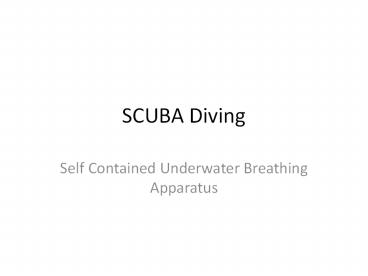SCUBA Diving - PowerPoint PPT Presentation
Title:
SCUBA Diving
Description:
SCUBA Diving Self Contained Underwater Breathing Apparatus PADI Open Water Course Course Requirements must be completed for certification Knowledge development ... – PowerPoint PPT presentation
Number of Views:3860
Avg rating:3.0/5.0
Title: SCUBA Diving
1
SCUBA Diving
- Self Contained Underwater Breathing Apparatus
2
PADI Open Water Course
- Course Requirements must be completed for
certification - Knowledge development- completed before pool
- Read PADI manual, complete worksheet, Video and
quiz for all 5 chapters - Pass PADI final exam
- 2 pool practice sessions
- 4 ocean dives, 2 per day
3
Water Pressure and Air Volume
- At Sea level the weight of the atmosphere above
us exerts a pressure of 1 Atmosphere (14.7 psi)
on us - Water is heavier than air so it only takes 33
feet of water to equal 1 ATM of pressure - At 33 feet under water you are at a pressure of 2
ATM, 1 from the atmosphere and 1 from the water
above you - Pressure increases by 1 ATM every 33 feet(10
meters)
4
Water Pressure and Air volume
5
Depth, Pressure and air Density
6
Depth, Pressure and Surface Equivalent
7
Increasing Pressure and Body Air Spaces
- Body air spaces include Lungs, inner ear, sinuses
and mask and possibly teeth fillings - To equalize your ears and sinuses pinch your nose
and blow gently against it - To equalize your mask exhale out your nose adding
air to the mask - If you cannot equalize stop your descent
immediately, signal your buddy or instructor - An unequalized air space is called a squeeze
8
Equalization of Air Spaces
- Ascend slightly until discomfort passes and try
again, after you equalize descend slower and
equalize more often - Continuing to descend with unequalized air spaces
can lead to dammage to the eardrum - An unequalized mask can cause bruising around the
eyes - If you cannot equalize stop the dive
9
Equalization of Air Spaces
- Never attempt a forceful or extended equalization
- Use short gentle, frequent equalizations
- Never dive with a cold or allergy, congestion can
block sinuses and air passages - Cold medications can wear off during a dive
- Never use ear plugs or goggles while diving
10
Equalization of Air Spaces
- Lung equalization is accomplished by normal
continuous breathing - Skin (Breath Hold) Diving poses special problems,
do not descend after exhaling or breath hold
diving deeper than 200 feet - Do not Dive with lung congestion which can trap
air
11
Effects of Decreasing Pressure on Air Spaces
- Air pressure decreases during ascent
- Expanding air must exit the body
- This happens naturally in your ears, sinuses and
mask - Expanding air in your lungs is most important
- Normal breathing while ascending will release
expanding air from your lungs - Never Hold your breath While on SCUBA
12
Effects of Decreasing Pressure on Air Spaces
- Most Important Rule in SCUBA is Always Breath
- Lung over expansion can happen in as little as 3
feet, a slight pressure change - Lung over expansion injuries are difficult to
treat and can cause paralysis and death by
forcing air into the blood stream and chest
cavity - Anytime the regulator is not in your mouth exhale
a slow steady stream of bubbles
13
Effects of decreasing Pressure on Air Spaces
- Reverse Blocks result when expanding air becomes
trapped in a body air space - Reverse blocks can occur when diving with a cold
or allergy or using cold medicine - Gas can form in the stomach or intestine and may
take time to pass - A tooth squeeze is rare but can happen if air is
trapped under a filling - If you feel discomfort on ascent, stop descend a
few feet, give the air time to escape and ascend
slower
14
Breathing Underwater
- Pressure increases with depth and decreases air
volume - Each breath fills the same lung volume so more
air is needed to fill each breath - The deeper you are the faster you use air
- A tank of air that lasts 1 hour at 0 feet will
last ½ hour at 33 feet (10 meters)































